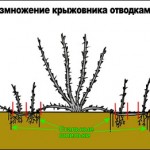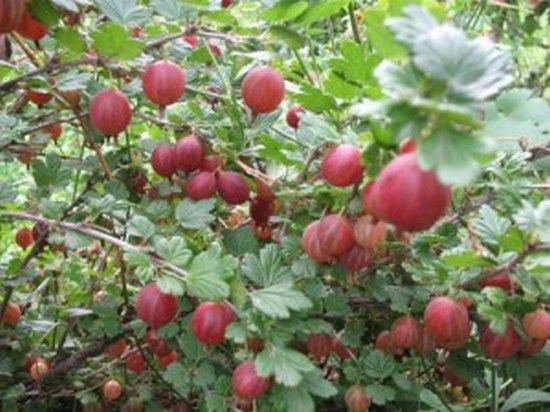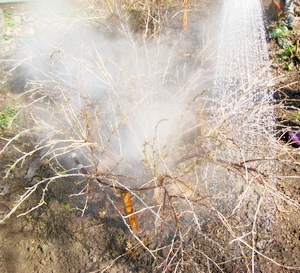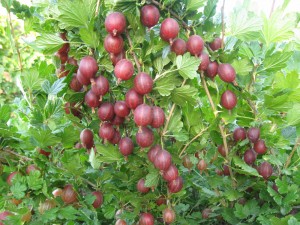In order for gooseberries to always please you with a good harvest, you need to be very careful when choosing planting material and choosing the place where you are going to plant it.
Gooseberries grow poorly in the shade, in drafts and on heavy clay soils. Does not tolerate damp, waterlogged places at all. There it grows very slowly, suffers from fungal diseases and often dies.
Almost all gooseberry varieties are self-pollinating. Therefore, if you plant several different varieties nearby, the yield will increase, as well as the quality of the berries will improve and they will be larger.
Gooseberries can be planted in early spring, before buds open and in autumn. The best time for planting is October. Before frost, the young bushes will have time to take root and, with the arrival of spring, will grow together.
Planting holes are dug 40 cm deep and 60 cm in diameter. Add a bucket of rotted manure and one glass of ash and superphosphate to each hole. If the soil is clayey, then you need to add a bucket of sand. When planting, it is better to deepen the root collar by 6-7 cm. This stimulates the development of additional roots.
After planting, you need to trim the shoots, leaving only 4-5 buds on them.. This promotes better survival rate, as well as branching of the bush. After this, the planted gooseberry bushes should be well watered and the holes should be mulched. In winter, it is better to cover the seedlings with 8-10 cm of soil.
Gooseberry care
The width of the tree trunk circle should be 1-1.2 m. In order to suppress the growth of weeds, the hole should be well mulched. Gooseberries do not like waterlogged soil, so watering should
be moderate. You should start feeding gooseberries 2-3 years after planting. In early spring, fertilize with nitrogen and potassium fertilizers, and after flowering, water with a liquid solution of mullein (1:10) at the rate of 5-10 liters. on the bush. To do this, make a groove around the bush and pour the prepared solution into it. After absorption, smooth out the groove.
To combat diseases there is one very simple and at the same time very effective method. In early spring, before the buds open, you need to water the gooseberry bushes with boiling water.. It is necessary to water from a watering can, using a bucket of boiling water for one adult bush. Don't be afraid to harm your plants.
Only pests die from this “barbaric” procedure. Referring to my personal experience, I can say that I have been using this method for 20 years and during this time our gooseberries
I have never been sick with anything.
Gooseberry pruning
An adult bush should have 20-25 branches of different ages. To form such a bush, you need to leave 3-4 young shoots every year and remove the rest. It is necessary to leave the most powerful shoots that grow in different directions. After 6-7 years, you can begin to cull old branches. They usually come in black.
If it is difficult for you to determine which branches are the oldest, then simply cut out those that are frozen, dry, creating excessive thickening or lying on the ground. If you deleted 3-4 such branches, then leave the same number
Long branches that hang to the ground also need to be trimmed. Otherwise, the shoot that touches the ground will very quickly take root and begin to develop as an independent bush. If you need to increase the number of gooseberry bushes, then in the spring it is enough to add a twig growing low above the ground. Over the summer it will take root and in the fall it can be cut off from the mother plant and planted in a permanent place.
Every year more and more new varieties of gooseberries appear. They differ in berry color, taste and size. Therefore, if possible, it is better to plant several different gooseberry varieties.
YOU CAN ALSO READ:
Planting remontant raspberries
Photo of honeysuckle, description of honeysuckle varieties




 CUCUMBERS NEVER GET SICK, I'VE BEEN USING ONLY THIS FOR 40 YEARS! I SHARE A SECRET WITH YOU, CUCUMBERS ARE LIKE THE PICTURE!
CUCUMBERS NEVER GET SICK, I'VE BEEN USING ONLY THIS FOR 40 YEARS! I SHARE A SECRET WITH YOU, CUCUMBERS ARE LIKE THE PICTURE! You can dig a bucket of potatoes from each bush. Do you think these are fairy tales? Watch the video
You can dig a bucket of potatoes from each bush. Do you think these are fairy tales? Watch the video
 How our fellow gardeners work in Korea. There is a lot to learn and just fun to watch.
How our fellow gardeners work in Korea. There is a lot to learn and just fun to watch. Eye trainer. The author claims that with daily viewing, vision is restored. They don't charge money for views.
Eye trainer. The author claims that with daily viewing, vision is restored. They don't charge money for views. A 3-ingredient cake recipe in 30 minutes is better than Napoleon. Simple and very tasty.
A 3-ingredient cake recipe in 30 minutes is better than Napoleon. Simple and very tasty. Therapeutic exercises for cervical osteochondrosis. A complete set of exercises.
Therapeutic exercises for cervical osteochondrosis. A complete set of exercises. Which indoor plants match your zodiac sign?
Which indoor plants match your zodiac sign? What about them? Excursion to German dachas.
What about them? Excursion to German dachas.
Dear, you haven’t had enough! Pour a bucket of boiling water onto the gooseberry bush! Yes, you cook it, all the bark will peel off after such treatment
Evgeniy P., thank you very much for taking such care of my gooseberries! I hasten to reassure you, our gooseberry is alive and well, and all its bark is in place. And in this way I have been processing all gooseberry bushes for many years. Sometimes I was late with processing and leaves appeared on the branches. So I poured boiling water even on the young leaves and not a single one was harmed. The harvest will ripen soon, I will definitely publish a photo.
Evgeny P., I promised to show you ripe gooseberries. The bottom photo is this year's harvest. As you can see, he’s alive and healthy and there’s not a trace of powdery mildew.
And why are these gooseberries of yours good for jam? I'd really like to try it
And how many berries can you pick from one gooseberry bush?
This gooseberry of ours is very suitable for jam! And the yield greatly depends on the variety and how you care for your gooseberries. But on average, you can collect 3 - 5 kg from an adult bush. berries
Don't be afraid to pour boiling water over the gooseberries. I, too, have been processing not only gooseberries, but also currants in this way for a long time. An excellent remedy for powdery mildew.